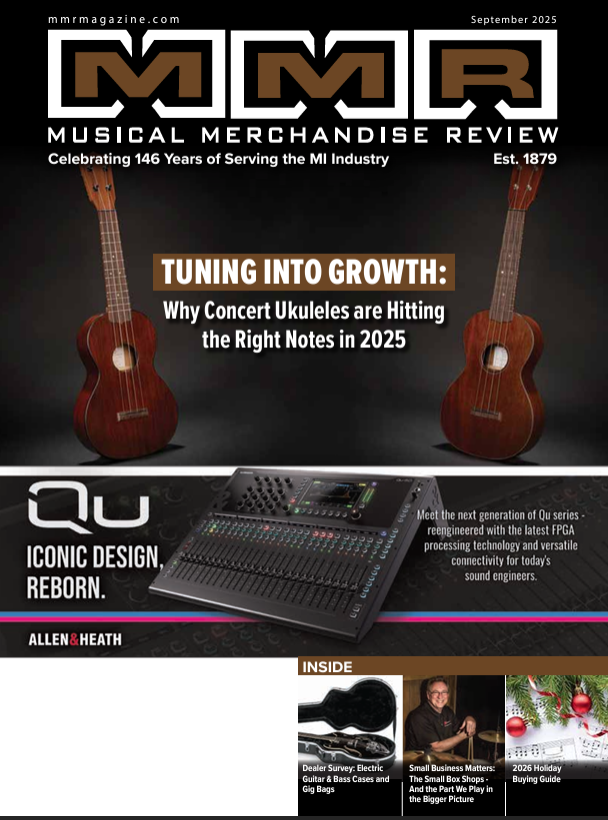 In Part I of this article, we looked at simple personal monitor mixing systems (PMMs for short) that let musicians hear themselves better. Now, we’ll examine the plethora of modular, networkable, multi-component solutions that can handle large groups and venues but still place monitor mixing under the control of individual musicians.
In Part I of this article, we looked at simple personal monitor mixing systems (PMMs for short) that let musicians hear themselves better. Now, we’ll examine the plethora of modular, networkable, multi-component solutions that can handle large groups and venues but still place monitor mixing under the control of individual musicians.
A main selling point is that these systems are scalable. By adding as much or as little hardware as needed, they work for a wide range of applications: touring acts who don’t want to be at the mercy of whatever monitor setup they may find at the next stop; nightclubs that have permanent front-of-house sound systems but don’t want to install or staff a dedicated monitor mixer; and venues with regular house bands and possibly rotating guest musicians, such as houses of worship or TV show sets.
The same modular approach that makes these systems so flexible can also make the buyer’s journey confusing. We could fill this issue with facts and features and still not do a proper “roundup” of all the brands and options, so instead we’ll look at the essential principles that will help you ask your customers the right questions.
WHAT COMPONENTS? HOW MANY?
The goal is the same as the one-box products we covered last month: To let each musician control his or her own monitor mix while affecting neither the house mix nor the monitor mixes of bandmates. But instead of one or two musicians having their own “more me” boxes or everyone sharing something like a JamHub, everybody has a mixing station that derives an individual mix from a common audio network.
Aviom was an early trailblazer in this area and they continue to be, and since, products including Hear Technologies, Digital Audio Labs LiveMix, Movek MyMix, the Behringer P-16 line, and more have taken the usual leapfrog turns in terms of features and bang-for-buck. A modular PMM system often (but not always; bear with me) consists of:
• At least one input module that converts all the band’s audio signals into digital information, then sends that information out over a computer-style Ethernet port. This connects to:
• A distribution module that has a bunch of Ethernet ports to split that information to a bunch of destinations. Which are:
• One or more personal mixers that let each band member control their own balance of sounds.
• Some brands offer a supplemental output module to send all signals somewhere further, such as a separate recording rig or centrally located bank of wireless in-ear transmitters.
Musician-controlled monitoring also shows up as part of full digital mixing systems that handle the whole show, such as the Avid Venue or Roland V-Mixer families. However, our scope here is stand-alone systems that can piggyback on an existing—and often old-school—house P.A.
Why did I say “but not always” a moment ago? Because not all brands require every type of component listed above. For example, HEAR Technologies’ Hear Back Hub combines both multi-channel input and Ethernet distribution functions in a one-rackspace unit, as does Behringer’s Powerplay P-16I. Some brands of personal mixers, such as the Allen & Heath ME-1, Behringer P-16M, and Aviom’s now-discontinued A-16 II, might not need the distribution module at all. Instead, they let you daisy-chain personal mixing stations together. Generally, if a personal mixer has two Ethernet ports on the back, it can be daisy-chained; if it has only one, it wants to be fed from a distribution point. Another option to look out for is that some personal mixers, including the A&H ME-1 and the Movek MyMix, can use off-the-shelf wired Ethernet switches for distribution. Be sure to check manufacturers’ recommendations about this.
Beyond scalability and individual control, here are three more key benefits to call out. First, the use of common, inexpensive Ethernet cables (Cat-5e, as a rule) minimizes the “spaghetti factor” of moving audio everywhere it needs to be, as one cable can carry many channels of audio bi-directionally. Second, cable runs of up to 300 feet can be accomplished without signal degradation. Third, although these systems tend to focus on live sound, a recording studio could use one to put artist-adjustable headphone mixes in every tracking room.
DOWNSTREAM VS. UPSTREAM INPUT
Figuring out how and where sound goes into the system will form your customers’ first impression of their new PMMs, long before they touch any bells or whistles on their personal mixers. There are two main ways to do this, each with consequences about what kind of input module you should recommend.
The most common and affordable PMM input modules are single-rackspace units with 16 or sometimes 24 analog ins that expect to see a line-level signal. They go downstream of the main mixer and thus keep things “business as usual” in terms of onstage setup: mics and instruments plug into the main mixer either directly or via a standard passive snake. The mixer then feeds an input module parked nearby. Ideally, the mixer should have pre-fader direct outputs for each of its input channels. Using direct outs means that one channel coming into the snake equals one channel going out over the PMM network, giving the musicians maximum monitoring flexibility. Some digital mixers can interface directly to a PMM via an optional output card, such as the one Aviom makes for Yamaha O1V96 and DM-series boards. Note also that with a line-level-only input module, the main mixer needs to come first anyway, as it will be providing any needed mic preamps.
For live gigging, the downstream setup is ideal for two sorts of customers: Venues that want to permanently integrate a PMM system, and bands that run their own front-of-house sound—think wedding and corporate-casual bands that tote their P.A. to hotel ballrooms, often handling sound from stage-side to keep gear and cables away from foot traffic.
It’s less ideal for touring bands who are faced with an ever-changing lineup of house P.A. gear and sound personnel. Even if they’re nerds enough to carry every type of adaptor cable known, shoehorning their input module into a crowded mixing booth during a too-brief sound check just may not fly. Here, the solution is to get everything into the PMM upstream of the main P.A.
A real standout for this application is the Movek MyMix line, because its personal mixers do double duty as mini input modules—with mic preamps! Each MyMix has two mic/line ins on XLR combo jacks, letting the musician plug right into the audio network. Each also has stereo line-level outs, which can then act as “thrus” for feeding the main P.A., or route the monitor mix into a powered floor wedge or wireless in-ear transmitter. Via the Power8 distribution module, all the Ethernet cables that carry the monitor mixes can reside onstage, making for a very self-contained solution. The MyMixes are also great for a rehearsal room where the PMM system is used instead of a PA.
Otherwise, the “upstream” approach gets either higher-end or more kludgey. On the kludgey side, bands can and do plop a line-level input module next to the stage snake and use whatever outputs they have on hand to get signals into both: aux sends from the keyboard submixer, “thru” outs from the guitar and bass amp heads or direct boxes, and so on. Mics will still need preamps, lest they be heard only in the house but not in the PMM system—so by now we’re talking about a lot of extra plumbing onstage.
In the higher-end direction, there are input modules that include mic preamps. The Aviom AN-16/i-M and dbx TR-1616 are two popular 16-channel examples. Both also pack 16 XLR outs for splitting everything to the house. These invariably cost more than line-level-only input modules, but they’re the bulletproof way for a band to take charge of its monitoring situation with virtually zero impact on connections and house workflow from the stage snake on down.
PERSONAL MIXER FEATURES
The personal mixer is the part of the system each musician interacts with most. At minimum, it’s a box with a volume knob, channel selection, a headphone jack, and an accessory for clamping onto a mic stand. Basic operation is the same across the entire brandscape: Select a channel and crank the knob up or down to adjust that signal in your monitor mix. Again, you can’t overemphasize the Big Idea that this won’t affect what anyone else hears.
User interfaces and convenience features is where personal mixers differentiate. Things manufacturers talk about and customers ask about include:
− Saving and recall of mix presets, a time-saver for when the band returns to a venue.
− Additional (line-level) output for feeding powered speakers or wireless in-ears.
− Stereo panning of signals in the monitor mix.
− Banks or groups to expand the number of adjustable mix channels.
− High-res display (sometimes a touchscreen) and onscreen naming of mix channels.
− Onboard effects for the monitor mix. (Great for vocalists who want reverb.)
− Power over Ethernet to avoid “wall wart” AC supply.
− Onboard recording to an SD card for capturing demos.
A couple of standouts we haven’t mentioned yet are Digital Audio Labs’ LiveMix CS-Duo, which can provide two musicians’ mixes with one unit, making it a good candidate for placement in a background vocal or horn section. Then, the PM-16 from Elite Core Audio has separate volume and pan knobs for every channel but no display or menus, trading programmability for easy-to-learn “analog” operation.
THE SKY’S THE LIMIT… BUT STAY DOWN TO EARTH
We’ve only scratched the surface of how Ethernet-based PMMs can be configured, and the scalability can range from the corner coffee house to a globally watched awards show. Multiple input modules can be used. What I’ve called “downstream” and “upstream” approaches can be combined. Some brands offer optional digital I/O for formats such as ADAT, MADI, and Dante, for interfacing with venues’ digital mixers or the broadcast truck parked outside. A large enough and properly configured system can handle channel counts in the hundreds.
Chances are, though, that the needs of the customer who walks into the music store are less grandiose. For getting started, many manufacturers offer bundles of an input module, network distributor, and several personal mixers as a single-SKU product.
A final thing both customers and retailers can love is that there’s a good deal of compatibility between brands. To take full advantage of features, it’s of course best to stick with one branded ecosystem of input, network distribution, and personal mixers. In the real world, musicians hop from band to band, and they may have invested in their own personal mixer that matches the system their old band had, whereas their new band uses a different one. So when considering a line, always ask “Do your personal mixers work with any other companies’ stuff?”
Bottom line: Any pro audio technology this flexible and configurable is bound to have a learning curve, but in the case of networked PMMs, the rewards are huge. Educate yourself so you can educate your customers about buying once and buying right.



























